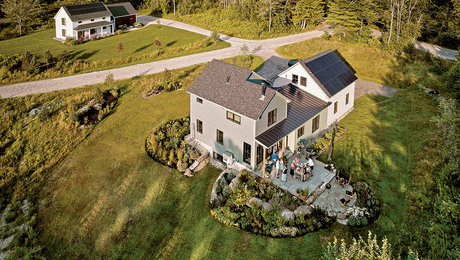I live in a Boston town house with chimneys built into shared party walls. Built around 1865 long before clay liners and code that demanded the 2″ clearance etc.
I’ve been using a gas fired boiler for almost 40 years vented into this type of chimney. When my neighbors boiler failed I suggested she change from oil to gas heat to save money. She decided to stay with oil partly because she was told that to change to gas she would need to line the chimney. I always thought that gas had cooler flue temperatures than oil and if anything the opposite would be true. Does anybody know why with gas she would need to line her chimney?
Separate question — same neighbor. She also has a fireplace into one of these unlined chimneys. I really don’t feel safe with her using this fireplace and have tried, unsucesfully, to convince her to cap it off and not use it. She recently had a chimney sweep clean it and he told her it would be fine to use with Duraflame type logs if she has it cleaned every year since these logs burn cooler but deposit a lot of soot. How would others feel about this situation?


















Replies
Sounds scary to me - both flues.
AFAIK, any of the newer appliances should be vented into relined flues, because the new efficient burner units end up produci9ng more acids condensing in the old flues. That acid will eventually eat away at the mortar. If the interior of her flue is larger than the outlet size of her appliance, it should have been re-lined. There is some room for variance with this up to a small percentage, and can vary by jurisdiction, but in these hard times, I can easily imagine an installer letting her talk him into a cheaper option to be able to get the job, or a hack proposing the option of no liner. Personally I can't imagine wanting oil if gas is available, given the lower cost to operate and maintain.
as a practical matter, the chimney sweep's advice my be correct, but it isn't really professional.
Things that can happen with the old unlined masonry chimney's
---creosote deposits can deliver you a chi9meny fire. Burning creosote on the inside of a chimney can burn hot enough to melt the mortar. This is not highly likely since most open fireplaces do not produce much creosote deposits and the man-=mde logs produce even less. So I would not worry too much on that IF she is only using the fake logs.
----but the other thing that I have seen WAY too often on old chimneys is that the old mortar is already done in, so there are crevices and gaps that let flame out or smoke and other dangerous exhaust gasses that penetrates the living spaces, - yours and hers. I'm aware of a couple cases where a closet sharing space in an old house had fire catch in it because of flames gapping through the old masonry.
--one would ASSUME??? that the chimney sweep used a camera to inspect all this before rendering the opinion that everything is fine for now...
---finally, old poor mortar joints cane mean the chimney begins to lean and become structurally unsound. This is more often the case with single flue chimneys. The larger amt of mass that is normal with common wall, multiple flue chimneys like yours tends to be more stable in that regard.
Welcome to the
Taunton University of Knowledge FHB Campus at Breaktime.
where ...
Excellence is its own reward!
The chimney sweep who also relines chimneys said the flues are to small to reline. He didn't look down the chimney with anything more than a hand held digital camera. In order for anyone to get to her roof they have to come up thru my house and I was up there with him.
I've always been nervous about holes leaking into my house and long ago I added CO detectors to every room that's adjacent to her chimney. That won't help if the heat sets the wood lath on fire but at least I'll be awake.
These houses have two chimneys and in order to gain more space in my house I tore down one of my chimneys. When I removed the plaster on lathe box that surrounded the chimney on the top floor I could see evidence of smoke escaping through a hole in the chimney. After further inspection I found that that flue was completely blocked above the hole and apparently the smoke went up in the space between the chimney and the plaster. And then vented out thru a gap where the roof flashing had pulled away. I'm guessing this dated back to when the house was heated with coal fire places. Long before my time. Seeing this in my house is one of the things made me uncomfortable about what's going on next door.
When you wrote "too small" to be relined, my first thought was that they must have been for coal originally.I don't know how he could have inspected much for a 14' to 32' flue with only a hand held camera unless he had a pretty long arm.Some guys get that way from delivering too much 5/8"sheetrock though
Welcome to the Taunton University of Knowledge FHB Campus at Breaktime. where ... Excellence is its own reward!
These are 5 story apartment buildings with high ceilings not single family houses. The flues are 50'. He's got a 'really' long arm. The one good thing about this is with a flue that long and that much draft. I'm guessing that any leak is probably going to be into the chimney and not out of the chimney.
True dat
Welcome to the Taunton University of Knowledge FHB Campus at Breaktime. where ... Excellence is its own reward!